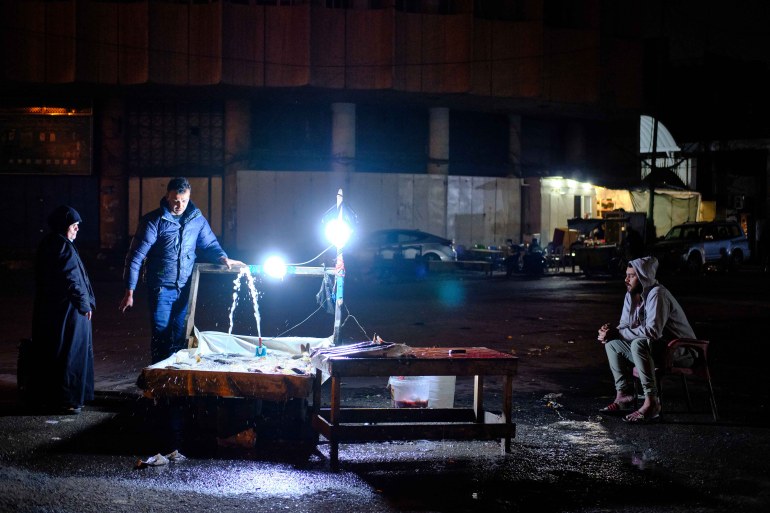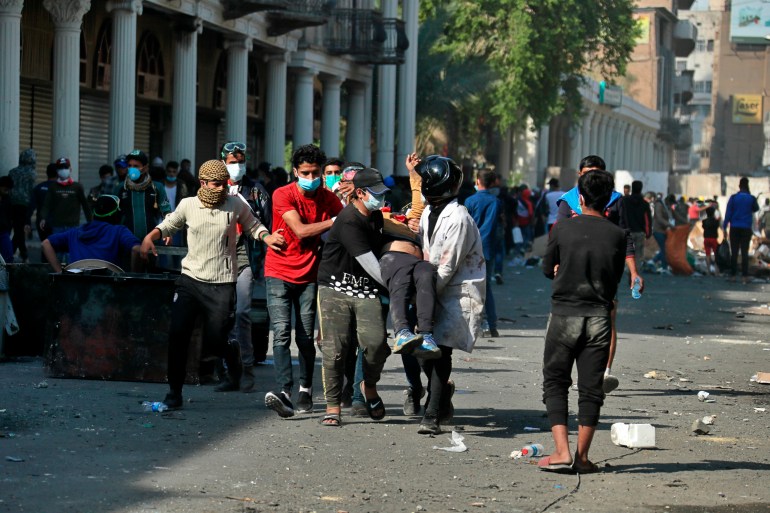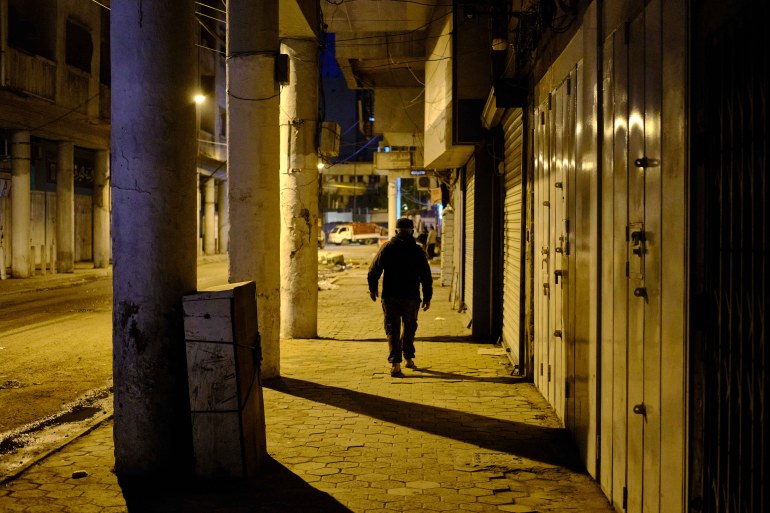Baghdad: A solitary walk through a crime scene
Poverty, fear and securitisation reign over Baghdad’s once-thriving downtown.

It was quiet in the gardens of Abu Nawas Street on a recent winter evening. I was taking a walk in downtown Baghdad and decided to stroll down the once-elegant boulevard stretching along the Tigris River.
Clouds of smoke spewed from rubbish being burned near the edge of the water, stray dogs barked among solitary men who drank alcohol hidden in plastic bags. A drunkard squeezed his penis and leisurely sprayed his urine into a puddle.
On the main road, the solemn faces of “martyred” and living militiamen in numerous street posters seemed to hurl threatening looks at the traumatised civilians stuck in traffic.
Militia flags fluttered in the wind from broken lamp posts. Some of them had “League of the Righteous” stamped in green against a white background. It felt like Abu Nawas street was keeping up with the times.
Several days earlier, armed men in camouflage had appeared on TV, claiming membership in the “League of the Righteous” and threatening the Iraqi prime minister himself for arresting one of their comrades who had allegedly planned a rocket attack on Baghdad’s occupied “Green Zone”.
A militiaman from another group had declared in a statement his intent to chop the prime minister’s ears off. As a result, the hashtag “al-Kadhimi’s ears” was trending for days on social media.
These daring threats were met with pompous tirades on sovereignty and the prestige of the state delivered by politicians endlessly pledging to enforce the rule of law in a lawless land.
For almost two decades now, they have failed miserably. Armed men still threaten, abduct and assassinate civilians at will. They still fire rockets clumsily at the US embassy which, instead of hitting it, kill innocent Iraqis.
According to Iraq Body Count, an organisation that records violent deaths in Iraq, 902 civilians were killed in 2020. Many of these victims died in the protests that came to be known as the October uprising for demanding a dignified life in a safe homeland.
Meanwhile, hunger continued to spread across Iraq at an incalculable pace. In the summer, the UN said it expected “poverty rates increasing to approximately 40 percent”. That was before the devaluation of the dinar, which further aggravated the suffering of Iraqis.
The reigning poverty was evident in Abu Nawas.
Children in mismatched flip-flops and ripped tracksuits sold juice and water near Mohammed Ghani Hikmat’s statues of Shahryar and Sheherazade. Exhausted vendors sat on the curb, hoping a driver would motion them over and buy whatever they sold for cheap.

But poverty was not the only palpable presence in the street. Although the Iraqi government is unable to guarantee the safety of its citizens, it nevertheless insists on securitising their public spaces.
Walking down Abu Nawas that evening, I felt as if I was visiting barracks. Parts of the sidewalks were surrounded by concertina wire or occupied by military vehicles. In the span of an hour, I was stopped three times by security force members for having a camera hanging from my neck.
“Where are you going?” one of those said in a commanding tone, before asking me to take a photo of him.
As I was walking, I thought of Abu Nawas’s famous masgouf restaurants serving the best traditional grilled carp. In a campaign to renovate the street in 2012, the municipality demolished them for – among other things – being used “in wrong ways”, i.e. serving alcohol.
Abu Nawas is still home to a few squalid liquor stores. When the sun comes down, these establishments are the only source of light in the long stretches of darkness along the street. So far, they have managed to pull through threats from the untouchable militiamen.
I soon descended from the main road into one of the street’s unkempt gardens to capture the sun’s last kisses with the Tigris. An old man was sitting in a children’s swing, swaying back and forth and gulping down a beer. What was he thinking of? Did he lose a brother or a sister to anonymous assassins? Or did America’s liberatory missiles obliterate his children?
With my camera in hand, I framed my shot, squeezed the shutter button and recited the words the late Iraqi poet Sargon Boulus wrote from his self-imposed exile:
Heavy with water
is the hair of the drowned man
Who returned to the party
After they turned off the lights
Piled the chairs on the barren riverbank
and chained the waves of the Tigris
From Abu Nawas, I made my way to al-Rashid Street, passing underneath al-Jumhouriya Bridge on the way. Jisr al-Jumhouriya is where security forces killed and hurt so many unarmed youths during the 2019-2020 protests.

It was then that Iraqis marched en masse demanding a “homeland”, but received live bullets instead.
As I made my way into al-Rashid, I looked in the direction of al-Tahrir square. Its palm trees were wrapped in white and green neon lights. Was it for Christmas? Even the palm trees, and Jawad Salim’s Freedom Monument, were hit by tear gas canisters in 2019.
As I was walking in al-Rashid Street, I remembered one of the victims of the crackdown – 26-year-old Saif Salman, whom I met in 2019 when he was recovering at a Médecins Sans Frontières hospital in Baghdad. I decided to call to check on him. He broke into tears when we talked about the events of October 2019.
“I don’t regret it,” he said, sobbing over the phone. “It was a moral duty that I had to fulfil”.
On October 25, 2019, he joined crowds of angry youth on the bridge hell-bent on overthrowing the regime. A military-grade tear gas canister hit his right leg, lodging itself into the bone. His leg had to be amputated.
The current government pledged accountability and punishment for those who unleashed violence on the peaceful protesters. But protesters are still getting killed, and like millions of Iraqis, Salman did not believe these pledges. “We are already dead to them,” he told me.
By the time I finished my phone call, al-Rashid was cloaked in darkness. No cinephiles queued up outside the famous Cinema al-Zawra. Apart from a few soldiers, the city’s once most elegant street was empty.
A few street lamps worked, illuminating its ornate façades, withered after years of neglect. Carcasses of buildings, crumbling from the inside, leaned sideways barely standing on aching columns.
In its frequent forays into restoration works to polish the ancient city’s lost prestige, the municipality dispatches workers to paint these columns. The paint usually peels off a few days later.
As I made my way into the night, a young man appeared from a dark alleyway, and I asked if he lived here. “It is quiet here. Few families have remained,” he said.
He showed me a scar on his left arm. “This is from a stun grenade,” he said. He showed me another one from a bullet on his right leg. He too had joined the protests in 2019.
Footage on his phone showed people swarming in the middle of the same street where we stood. “They killed a guy here,” he pointed to a spot behind us.

“They say it was the Iranians. That’s a lie. It was the Iraqis who killed protesters,” he said, referring to the Iraqi security forces.
I said goodbye and continued my stroll through downtown Baghdad. I passed what once was the McKenzie bookshop, now a footwear store: a transformation well exemplifying the steep nose-dive the country took into the abyss after the US invasion of 2003.
I could see stray dogs rummaging through rubbish bags piled on the sidewalks. They reminded me of the dogs that gnawed on the corpses lying in the streets of Baghdad at the climax of the mayhem America’s emancipatory quest unleashed in 2003.
Eighteen years have passed, and yet Baghdad still feels like it is amidst a war. Military helicopters still roar over impoverished alleys where youth are doomed to a miserable existence, to go out looking for work only to return home in a coffin, to have their portraits adorn living rooms where old women sit in silence, drowned in unassuaged grief.
The views expressed in this article are the author’s own and do not necessarily reflect Al Jazeera’s editorial stance.
